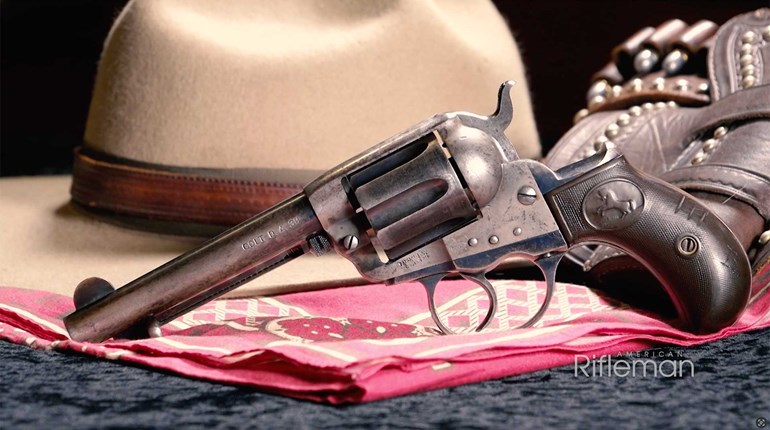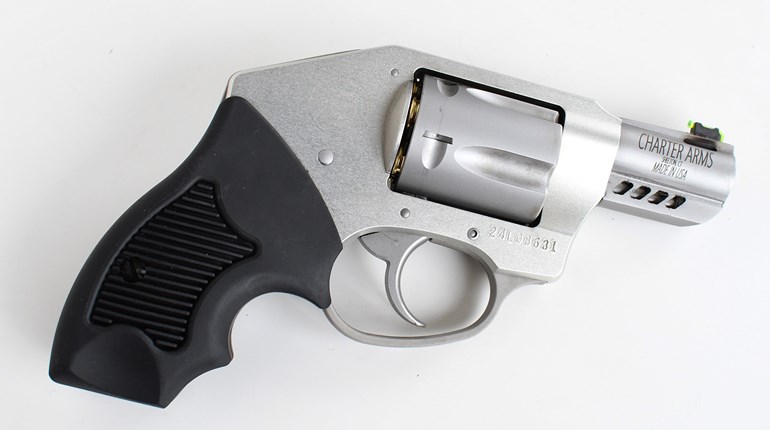
Compact double-action revolvers are popular concealed carry choices, but their limited capacity can be a drawback. An empty revolver is useless, and in a personal protection incident it behooves the shooter to get it reloaded quickly.
A full cylinder reload (commonly called an Emergency Reload) is done with either the strong hand or weak hand technique. A speed loader or moon clip is quickest, but a stripper clip or loose rounds can be used. The terms strong and weak hand can be misleading. They refer to which hand installs the new rounds into the gun, not which hand is holding the gun, nor which is the shooter's actual dominant hand.
Since cylinder swings out to the left, with the cylinder release also located on the left, it's extremely difficult for a southpaw to open the cylinder with the gun in a left hand shooting grip. Many southpaws find it's faster to shift the gun to the right hand for the reload, making the right hand the Strong hand.
Strong Hand Reload

The strong hand reload begins with the gun in the right hand. The right thumb activates the cylinder release. Simultaneously, the left hand slides under the trigger guard to the right side of the revolver and the two middle fingers push the cylinder open and remain in contact to hold it open while the two outer fingers lock onto the right frame side for support. The muzzle is then rotated upwards to eject the fired cases. The gun is now fully-controlled by the left hand, and that thumb is in position to push the ejector rod to dump the cases. With a full-size .38/.357 revolver, and its longer ejector rod stroke, that is effective.
That can also work with a snubby using 9 mm rounds in a moon clip, but is a poor choice for .38 Special-length rounds. The shorter ejector rod stroke will only clear about 60 percent of a .38 Special case from the chambers. A better method is to bring the palm of the right hand sharply down onto the ejector rod to drive the empties out. The the right hand can then grab the reload, while the gun is rotated muzzle downward to insert it.
When the rounds are inserted the empty reloading device is dropped, the left thumb snaps the cylinder back into the frame, and the right hand re-assumes the firing grip, or shifts the gun to the left hand for a southpaw. With the strong hand technique the reloading device must be carried in a place that gives the right hand quick access to it.
The advantage to the strong hand reload is the positive control via the left hand to keep the cylinder open, and quickly close it after the reload. In addition, an errant round that misses a chamber will normally wind up in the palm of the left hand under the cylinder, where it can quickly be grabbed and inserted. That is why, during the days when LEOs were equipped with revolvers and dump pouches, this was the preferred reloading method taught.
Weak Hand Reload

The weak hand technique gained popularity when revolvers commonly became chambered for cartridges using moon clips. With this method the gun never leaves the right hand.
The right thumb activates the cylinder release. The cylinder can then be opened by the support hand sliding underneath (like the strong hand) or with the trigger finger. Regardless of which is employed the trigger finger must come up and poke through the frame from the right to hold the cylinder open or the cylinder can slip back into the frame and impede ejection.
The right hand then has full control of the gun as the muzzle is turned upwards to eject the empties. That leaves the left hand to eject the round with the thumb, or "palm smack." Once the empties are out the muzzle is inverted, and the left hand grabs the loading device (which should be carried where the left hand can easily reach it) and inserts the rounds. The empty loading device is discarded and the left hand closes the cylinder, leaving the gun in the right hand, or shifted to the left hand. It can be as fast as the strong hand technique, but there are two potential drawbacks.
Shooters with small hands may have difficulty holding the cylinder open with the trigger finger, and a flopping cylinder will trash the reload. Shooters with large hands may find their normal firing grip puts their shooting hand thumb close to the base of the cylinder when opened, and ejected rounds may jam into it, stopping extraction. This is not a problem with a full-sized revolver, but a very real possibility with a . 38 Special/.357 Magnum snubby.
The hand manipulations may sound complex, but with practice they can become one fluid movement. Skilled competitive revolver shooters can fire the last round in the cylinder, execute either reload, and fire the first round in the recharged cylinder in under 3 seconds. Snubbies may not be that fast, but an under 5 seconds is realistic.
Tactical Reload

Both of the these reloading techniques clear and recharge all chambers. However, that may not always be needed. If only a couple of rounds have been fired, and if the situation has lulled to the point where a shooter can gain cover and reassess, topping off a couple of fired rounds with a tactical reload may be indicated. This is best done with the strong hand technique because one hand has to control and operate the cylinder while the other extracts spent rounds and replaces them.
The tactical reload has the cylinder opened and positively secured by the left hand, as with the strong hand reload. The muzzle is directed downwards, while the left thumb gently raises the ejector rod. The empty cases are located and the right hand puts fingers in contact with them. The ejector rod is lowered, which drops the loaded rounds back into their chambers, leaving the empties up, accessible, and easily removed. The right hand then fills those chambers with a stripper clip or loose rounds, while the left hand snaps the cylinder closed.
By the way, these techniques can be employed in conjunction with Ed Head's excellent reloading drill article and can make these complex movements instinctive. That can be critical if a shooter has to make a rapid revolver reload.




































